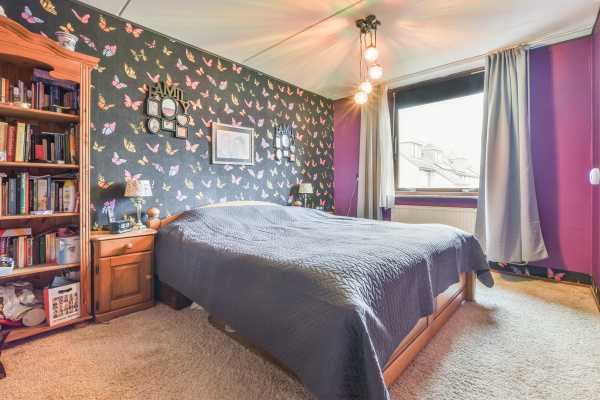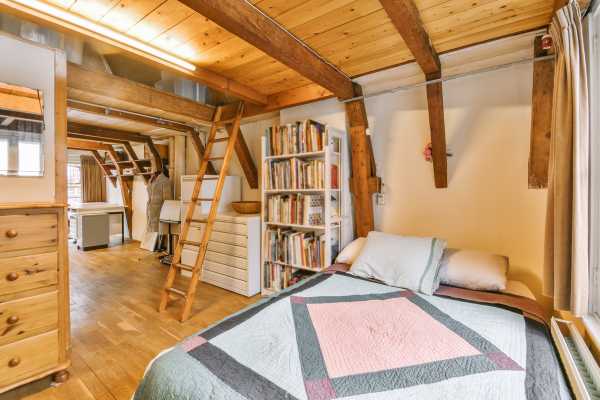The placement of a bookshelf in a bedroom is a critical aspect of both functionality and aesthetic appeal. Strategically positioning the bookshelf can maximize space utilization, enhance room flow, and elevate the overall design. It’s important to consider factors like natural light, room layout, and accessibility when deciding where to place a bookshelf. Ideally, it should complement other elements in the room without overcrowding it. A well-placed bookshelf not only stores and displays items efficiently but also becomes an integral part of the bedroom’s decor, contributing to a harmonious and inviting atmosphere. Thoughtful placement can transform a bookshelf into more than just storage; it can be a focal point that adds character and charm to the bedroom.
Assessing Bedroom Layout and Space

Evaluating the bedroom’s layout, size, and existing furniture is crucial when considering bookshelf placement. Understanding the room’s dimensions helps in selecting a bookshelf that fits comfortably without overwhelming the space. The layout dictates the flow of movement and can influence where a bookshelf can be placed for easy access and minimal disruption.
Existing furniture and their arrangement should be taken into account to ensure the bookshelf complements and enhances the overall decor, rather than clashing or causing congestion. Assessing these factors allows for a strategic placement of the bookshelf, making it a seamless addition that boosts both the room’s functionality and aesthetic appeal. Careful consideration of the bedroom’s layout and space ensures the bookshelf serves as a practical and stylish component of the room.
Utilizing Underutilized Spaces

Placing bookshelves in often overlooked spaces in bedrooms can be a clever way to maximize storage and enhance room aesthetics. Corners, which are frequently unused, can be ideal for corner bookshelves, turning these nooks into cozy reading spots or display areas. Alcoves, another underutilized space, offer a perfect recess for built-in shelves, providing a custom look and saving valuable floor space.
Installing shelves above other furniture, like beds or dressers, is a smart way to utilize vertical space, especially in small bedrooms. These innovative placements not only help in organizing and decluttering but also add an element of surprise and creativity to the room’s design. Utilizing such spaces for bookshelves can transform them from being merely functional to becoming integral parts of the bedroom’s charm and character.
Integrating Bookshelves with the Bed

Integrating bookshelves with the bed can create a harmonious and functional bedroom setup. Incorporating bookshelves into the headboard offers a convenient and stylish way to store and access books right from the bed, making it ideal for avid readers. This design can also include features like built-in reading lights or hidden compartments. Adding bookshelves to the footboard can be a creative way to utilize space, especially in small bedrooms.
Flanking the bed with bookshelves creates a symmetrical and balanced look, providing ample storage and a sense of enclosure. This arrangement can be particularly effective in larger bedrooms, where it helps to define the sleeping area. These innovative approaches to combining beds and bookshelves not only optimize space but also enhance the overall aesthetic and utility of the bedroom.
Maximizing Wall Space

Maximizing wall space in bedrooms, particularly small ones, can be effectively achieved through the use of full wall bookshelves or floating shelves. Full wall bookshelves create a striking visual impact while offering extensive storage and display options. They utilize the vertical space from floor to ceiling, making the most of every inch available. Floating shelves, on the other hand, offer a more minimalist approach.
They can be strategically placed at various heights to accommodate different items, from books to decor, and their sleek design helps maintain a sense of openness in the room. Both options allow for efficient organization without sacrificing valuable floor space. Utilizing wall space with these shelving solutions is not only practical for storage but also adds a decorative element, enhancing the room’s overall look and feel.
Window Adjacency Considerations

Placing bookshelves near windows in bedrooms requires careful consideration to balance natural light and unobstructed views. It’s important to position the bookshelf in a way that it benefits from daylight, which can highlight the contents and create a pleasant reading spot, without blocking the light source. Low or narrow shelves under the window can be ideal, utilizing the space efficiently while keeping the window area clear.
For larger bookshelves, placing them perpendicular to the window avoids obstructing the view and allows light to flow into the room. Additionally, choosing a bookshelf with an open back or a lighter color can help maintain a bright and airy feel. Thoughtful placement and design choices ensure that the bookshelf enhances the room’s ambiance by taking advantage of natural light, without compromising on the view or the overall aesthetic.
Creating a Reading Nook

Creating a reading nook in the bedroom by combining a bookshelf with a comfortable reading area can transform a simple space into a personal retreat. Positioning the bookshelf near a window takes advantage of natural light, ideal for daytime reading, while providing a scenic backdrop. Adding a cozy armchair or a plush beanbag alongside the bookshelf creates an inviting spot. In smaller bedrooms, utilizing a corner for a bookshelf with a built-in seat can maximize space and provide a snug reading area.
Including soft cushions, a warm throw, and a small side table enhances comfort and convenience. Good lighting is key; a floor lamp or a wall-mounted reading light ensures sufficient illumination for evening reading. This setup not only encourages relaxation and leisure but also adds a charming and functional element to the bedroom’s decor.
Bookshelf as a Room Divider

Using a bookshelf as a room divider in larger bedrooms is an innovative way to create distinct areas within a single space. This approach works well for separating a workspace or study area from the sleeping section, maintaining a balance between work and relaxation. Choosing a tall, open-backed bookshelf allows light to filter through while providing ample storage and display space.
This type of divider maintains an airy feel in the room and offers accessibility from both sides. For a more solid separation, a full-backed bookshelf can be used, which also adds an element of privacy. Placing the bookshelf perpendicular to the walls creates a natural division. Helping to clearly define each area’s function while keeping the overall space unified. This versatile solution enhances functionality and adds a sophisticated design element to the bedroom.
Balancing Room Aesthetics

Maintaining balance and symmetry in room aesthetics is essential when placing bookshelves in bedrooms, as it greatly influences the overall harmony and appeal of the space. The bookshelf should complement the existing décor theme, rather than overpower it. Symmetrical placement, such as flanking a bed or a window with identical bookshelves, can create a sense of order and elegance.
Alternatively, a single large bookshelf can serve as a focal point if balanced with other elements in the room. Like art or furniture. It’s important to consider the color, style, and material of the bookshelf to ensure it integrates seamlessly with the room’s theme. The goal is to achieve a cohesive look where the bookshelf enhances the room’s ambiance. Contributing to a well-designed and aesthetically pleasing bedroom.
Incorporating Bookshelves into Existing Furniture Layout
Incorporating bookshelves into a bedroom without disrupting the current furniture layout requires strategic planning and creative use of space. Utilizing vertical space is an effective approach, as tall, slender bookshelves can provide ample storage without occupying much floor area. This can be especially useful in small bedrooms where space is limited. Another strategy is to integrate bookshelves with existing furniture.
For example, placing a bookshelf above or beside a dresser or wardrobe can create a unified look while maximizing space usage. In larger bedrooms, bookshelves can be used to complement other furniture pieces. Like placing them opposite a bed or alongside a seating area. These strategies ensure that the addition of bookshelves enhances the room’s functionality and aesthetic appeal without disrupting the harmony of the existing furniture arrangement.
Safety and Accessibility
Safety and accessibility are paramount when it comes to bedroom bookshelves, especially in children’s rooms. It’s crucial to securely anchor bookshelves to the wall to prevent tipping, which is a significant safety hazard. For children’s bedrooms, ensuring that bookshelves are sturdy and stable, with no sharp edges, is vital for preventing accidents. Accessibility is another key aspect.
The height and arrangement of shelves should be considered so that they are easily reachable. In children’s rooms, lower shelves are advisable for easy access to books and toys. While higher shelves can be used for less frequently used items or decorative objects. Ensuring that bookshelves are both safe and accessible enhances the room’s functionality and safety. Providing peace of mind while supporting a comfortable and engaging environment.
Final Touches and Personalization
Decorating and personalizing bookshelves is an excellent way to reflect individual styles and interests. Transforming them into both functional storage and a focal point in the bedroom. Start by arranging books in an aesthetically pleasing manner, such as by color, size, or genre. Intersperse with personal items like framed photos, travel souvenirs, or cherished collectibles to add a unique touch.
Plants can bring a pop of greenery and freshness to the space. Utilize decorative boxes or baskets on lower shelves for stylish yet practical storage. Art pieces or prints can be leaned against the back of the shelves for an artistic flair. Don’t forget to leave some open space to avoid a cluttered look, allowing each item to stand out. These final touches and personalization make the bookshelf a true representation of one’s personality while keeping it organized and pleasing to the eye.
Conclusion
Choosing the right spot for a bookshelf in a bedroom hinges on both functionality and design. Placing it near the bed offers easy access to bedtime reading, while a corner installation can maximize unused space. Consider utilizing the area behind the door for a slim bookcase that doesn’t encroach on valuable square footage. For those with larger bedrooms, positioning a bookshelf as a room divider can create a dedicated reading nook. It’s important to balance practicality with aesthetics, ensuring the bookshelf enhances the room’s decor and contributes to a relaxing atmosphere. Ultimately, the best location will seamlessly blend convenience with personal style, making the bedroom both a comfortable retreat and a celebration of literature.
